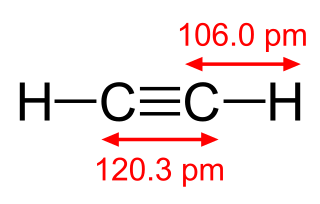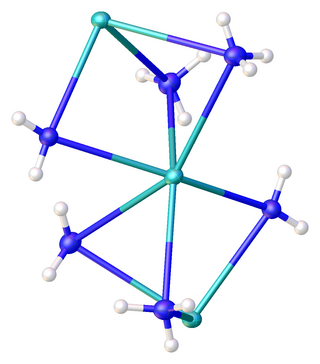
Acetylene is the chemical compound with the formula C2H2 and structure H−C≡C−H. It is a hydrocarbon and the simplest alkyne. This colorless gas is widely used as a fuel and a chemical building block. It is unstable in its pure form and thus is usually handled as a solution. Pure acetylene is odorless, but commercial grades usually have a marked odor due to impurities such as divinyl sulfide and phosphine.

Calcium carbide, also known as calcium acetylide, is a chemical compound with the chemical formula of CaC2. Its main use industrially is in the production of acetylene and calcium cyanamide.
In organometallic chemistry, acetylide refers to chemical compounds with the chemical formulas MC≡CH and MC≡CM, where M is a metal. The term is used loosely and can refer to substituted acetylides having the general structure RC≡CM. Acetylides are reagents in organic synthesis. The calcium acetylide commonly called calcium carbide is a major compound of commerce.
Iodine pentafluoride is an interhalogen compound with chemical formula IF5. It is one of the fluorides of iodine. It is a colorless liquid, although impure samples appear yellow. It is used as a fluorination reagent and even a solvent in specialized syntheses.

Scandium(III) sulfide is a chemical compound of scandium and sulfur with the chemical formula Sc2S3. It is a yellow solid.

Silver acetylide is an inorganic chemical compound with the formula Ag2C2, a metal acetylide. The compound can be regarded as a silver salt of the weak acid, acetylene. The salt's anion consists of two carbon atoms linked by a triple bond, thus, its structure is [Ag+]2[−C≡C−]. The alternate name "silver carbide" is rarely used, although the analogous calcium compound CaC2 is called calcium carbide. Silver acetylide is a primary explosive.
Copper(I) acetylide, Kupfercarbid or cuprous acetylide, is a chemical compound with the formula Cu2C2. Although never characterized by X-ray crystallography, the material has been claimed at least since 1856. One form is claimed to be a monohydrate with formula Cu
2C
2.H
2O is a reddish-brown explosive powder.

Lithium tetrachloroaluminate is an inorganic compound with the formula Li[AlCl4]. It consists of lithium cations Li+ and tetrahedral tetrachloroaluminate anions [AlCl4]−.

Acetylenediol, or ethynediol, is a chemical substance with formula HO−C≡C−OH (an ynol). It is the diol of acetylene. Acetylenediol is unstable in the condensed phase, although its tautomer glyoxal (CHO)2 is well known.

Potassium amide is an inorganic compound with the chemical formula KNH2. Like other alkali metal amides, it is a white solid that hydrolyzes readily. It is a strong base.
The nitridoborates are chemical compounds of boron and nitrogen with metals. These compounds are typically produced at high temperature by reacting hexagonal boron nitride with metal nitrides or by metathesis reactions involving nitridoborates. A wide range of these compounds have been made involving lithium, alkaline earth metals and lanthanides, and their structures determined using crystallographic techniques such as X-ray crystallography. Structurally one of their interesting features is the presence of polyatomic anions of boron and nitrogen where the geometry and the B–N bond length have been interpreted in terms of π-bonding.

Barium carbide is a chemical compound in the carbide family having the chemical formula BaC2.

Hydromelonic acid, is an elusive chemical compound with formula C
9H
3N
13 or (HNCN)
3(C
6N
7), whose molecule would consist of a heptazine H3(C
6N
7) molecule, with three cyanamido groups H–N=C=N– or N≡C–NH– substituted for the hydrogen atoms.
The inorganic imide is an inorganic chemical compound containing

Europium(II) chloride is an inorganic compound with a chemical formula EuCl2. When it is irradiated by ultraviolet light, it has bright blue fluorescence.
A chloride nitride is a mixed anion compound containing both chloride (Cl−) and nitride ions (N3−). Another name is metallochloronitrides. They are a subclass of halide nitrides or pnictide halides.
Phosphide carbides or carbide phosphides are compounds containing anions composed of carbide (C4−) and phosphide (P3−). They can be considered as mixed anion compounds. Related compounds include the phosphide silicides, germanide phosphides, arsenide carbides, nitride carbides and silicide carbides.
An iodide nitride is a mixed anion compound containing both iodide (I−) and nitride ions (N3−). Another name is metalloiodonitrides. They are a subclass of halide nitrides or pnictide halides. Some different kinds include ionic alkali or alkaline earth salts, small clusters where metal atoms surround a nitrogen atom, layered group 4 element 2-dimensional structures, and transition metal nitrido complexes counter-balanced with iodide ions. There is also a family with rare earth elements and nitrogen and sulfur in a cluster.
Carbide chlorides are mixed anion compounds containing chloride anions and anions consisting entirely of carbon. In these compounds there is no bond between chlorine and carbon. But there is a bond between a metal and carbon. Many of these compounds are cluster compounds, in which metal atoms encase a carbon core, with chlorine atoms surrounding the cluster. The chlorine may be shared between clusters to form polymers or layers. Most carbide chloride compounds contain rare earth elements. Some are known from group 4 elements. The hexatungsten carbon cluster can be oxidised and reduced, and so have different numbers of chlorine atoms included.
Strontium carbide (also more precisely known as strontium acetylide or strontium dicarbide) is a salt with chemical formula SrC2. It was first synthesized by Moissan in 1894.









